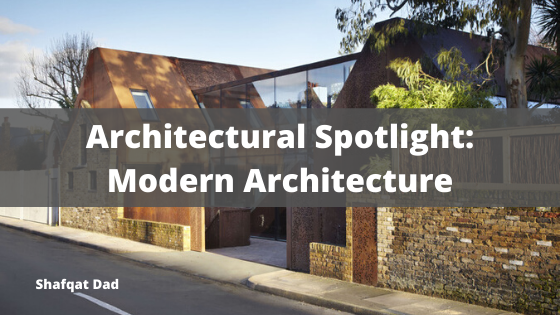In my previous blogs, I have written about a number of architectural types or styles. Each one denotes a time period showcasing advancements in design, building materials, and engineering. Each architectural style is inspired by its predecessor; each uses the same elements but adds a unique characteristic to it. For example, Italianate uses columns inspired by the ancient Greeks. Yet, the Italianate columns are much simpler in design than the Greek columns. As the centuries wore on, advancements in engineering provided stronger buildings and new materials created new designs (i.e. aesthetics). Almost all of the architectural styles were ornate in some shape or form — except modern architecture.
Modern architecture, like all architectural styles, was born from the reaction to the ornate styles, such as Classical, Italianate and Victorian. It has taken the opposite route, promoting clean lines and contrast colours. The first noticeable element of modern architecture is its shape, which creates sharp corners and protruding roofs. The buildings and homes are square and are devoid of the warmer and moldable elements the previous styles used, such as wood and plaster. The materials are cold in look and texture: iron, metal, and concrete. Yet, the inside of a modern home is the opposite with warm colors, along with wood and marble. What’s interesting is that many put modern and contemporary architectural styles in the same category. However, they are not the same. Contemporary style is all about what is trendy now, such as sustainable materials and smart devices. Modern might have a similar look, but this style is not eco-friendly. Its design is a reaction to the art of the modernist movement.
These buildings make use of glass, steel, and reinforced concrete. We see this in the large glass-panel windows, concrete floors and a steel structure. In fact, these buildings are almost transparent with such large glass panels (floor to ceiling). Simplicity is another key element in modern architecture. This parlays into the core concept of form and function. There is no decoration or bright colors on the exterior. A truly modern home connects with nature through the use of materials and colors (e.g. shades of tan, brown, black and white) as well as its structure. Take the Kew House in London, for instance. It encompasses the elements of modern architecture with a mix of glass and steel set behind a 19th century stable wall.
Modern architecture was only for a brief period but it had a lasting effect. Homes and buildings of this architectural style stand out because of their connection to nature and simplicity. Modern architecture is to be revered for rebelling against the ornate styles of architecture while creating something new and bold.

